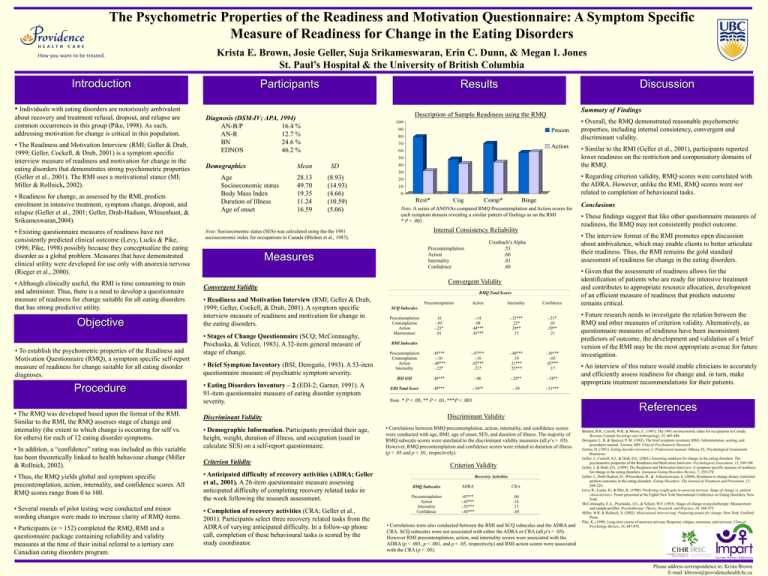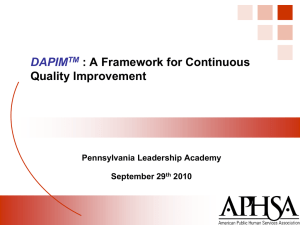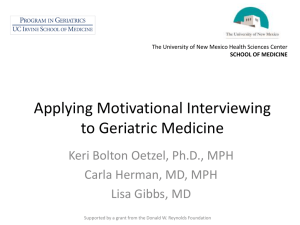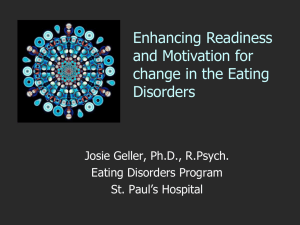RMQPoster
advertisement

The Psychometric Properties of the Readiness and Motivation Questionnaire: A Symptom Specific Measure of Readiness for Change in the Eating Disorders Krista E. Brown, Josie Geller, Suja Srikameswaran, Erin C. Dunn, & Megan I. Jones St. Paul’s Hospital & the University of British Columbia Introduction Participants • Individuals with eating disorders are notoriously ambivalent about recovery and treatment refusal, dropout, and relapse are common occurrences in this group (Pike, 1998). As such, addressing motivation for change is critical in this population. • The Readiness and Motivation Interview (RMI; Geller & Drab, 1999; Geller, Cockell, & Drab, 2001) is a symptom specific interview measure of readiness and motivation for change in the eating disorders that demonstrates strong psychometric properties (Geller et al., 2001). The RMI uses a motivational stance (MI; Miller & Rollnick, 2002). • Readiness for change, as assessed by the RMI, predicts enrolment in intensive treatment, symptom change, dropout, and relapse (Geller et al., 2001; Geller, Drab-Hudson, Whisenhunt, & Srikameswaran,2004). • Existing questionnaire measures of readiness have not consistently predicted clinical outcome (Levy, Lucks & Pike, 1998; Pike, 1998) possibly because they conceptualize the eating disorder as a global problem. Measures that have demonstrated clinical utility were developed for use only with anorexia nervosa (Rieger et al., 2000). • Although clinically useful, the RMI is time consuming to train and administer. Thus, there is a need to develop a questionnaire measure of readiness for change suitable for all eating disorders that has strong predictive utility. Objective • To establish the psychometric properties of the Readiness and Motivation Questionnaire (RMQ), a symptom specific self-report measure of readiness for change suitable for all eating disorder diagnoses. Procedure • The RMQ was developed based upon the format of the RMI. Similar to the RMI, the RMQ assesses stage of change and internality (the extent to which change is occurring for self vs. for others) for each of 12 eating disorder symptoms. • In addition, a “confidence” rating was included as this variable has been theoretically linked to health behaviour change (Miller & Rollnick, 2002). Summary of Findings Description of Sample Readiness using the RMQ Diagnosis (DSM-IV; APA, 1994) AN-B/P 16.4 % AN-R 12.7 % BN 24.6 % EDNOS 46.2 % 100 90 Precon 80 70 Action 60 50 Demographics Mean SD 40 30 Age Socioeconomic status Body Mass Index Duration of Illness Age of onset 28.13 49.70 19.35 11.24 16.59 (8.93) (14.93) (4.66) (10.59) (5.06) 10 0 Rest* Cog Comp* Binge Note. A series of ANOVAs compared RMQ Precontemplation and Action scores for each symptom domain revealing a similar pattern of findings as on the RMI * P < .001. Internal Consistency Reliability Convergent Validity Convergent Validity RMQ Total Scores • Stages of Change Questionnaire (SCQ; McConnaughy, Prochaska, & Velicer, 1983). A 32-item general measure of stage of change. • Brief Symptom Inventory (BSI; Derogatis, 1993). A 53-item questionnaire measure of psychiatric symptom severity. • Eating Disorders Inventory – 2 (EDI-2; Garner, 1991). A 91-item questionnaire measure of eating disorder symptom severity. Precontemplation Action Internality Confidence .16 -.05 -.23* .01 -.14 .08 .44*** .43*** -.32*** .22* .29** .15 -.21* .03 .29** .21 Precontemplation Contemplation Action Internality .45*** -.10 -.40*** -.22* -.47*** -.10 .62*** .21* -.40*** .14 .31*** .52*** -.36*** -.03 .42*** .17 BSI GSI .48*** -.06 -.28** -.34** EDI Total Score .49*** -.34** -.10 -.51*** SCQ Subscales Precontemplation Contemplation Action Maintenance RMI Subscales Note. * P < .05, ** P < .01, ***P < .001 • Several rounds of pilot testing were conducted and minor wording changes were made to increase clarity of RMQ items. • Completion of recovery activities (CRA; Geller et al., 2001). Participants select three recovery related tasks from the ADRA of varying anticipated difficulty. In a follow-up phone call, completion of these behavioural tasks is scored by the study coordinator. • These findings suggest that like other questionnaire measures of readiness, the RMQ may not consistently predict outcome. • Given that the assessment of readiness allows for the identification of patients who are ready for intensive treatment and contributes to appropriate resource allocation, development of an efficient measure of readiness that predicts outcome remains critical. • Future research needs to investigate the relation between the RMQ and other measures of criterion validity. Alternatively, as questionnaire measures of readiness have been inconsistent predictors of outcome, the development and validation of a brief version of the RMI may be the most appropriate avenue for future investigation. • An interview of this nature would enable clinicians to accurately and efficiently assess readiness for change and, in turn, make appropriate treatment recommendations for their patients. References • Correlations between RMQ precontemplation, action, internality, and confidence scores were conducted with age, BMI, age of onset, SES, and duration of illness. The majority of RMQ subscale scores were unrelated to the discriminant validity measures (all p’s > .05). However, RMQ precontemplation and confidence scores were related to duration of illness (p < .05 and p < .01, respectively). Criterion Validity • Anticipated difficulty of recovery activities (ADRA; Geller et al., 2001). A 26-item questionnaire measure assessing anticipated difficulty of completing recovery related tasks in the week following the research assessment. Conclusions Discriminant Validity Discriminant Validity • Demographic Information. Participants provided their age, height, weight, duration of illness, and occupation (used to calculate SES) on a self-report questionnaire. • Similar to the RMI (Geller et al., 2001), participants reported lower readiness on the restriction and compensatory domains of the RMQ. • The interview format of the RMI promotes open discussion about ambivalence, which may enable clients to better articulate their readiness. Thus, the RMI remains the gold standard assessment of readiness for change in the eating disorders. Cronbach’s Alpha .53 .66 .83 .80 Precontemplation Action Internality Confidence Measures • Readiness and Motivation Interview (RMI; Geller & Drab, 1999; Geller, Cockell, & Drab, 2001). A symptom specific interview measure of readiness and motivation for change in the eating disorders. • Overall, the RMQ demonstrated reasonable psychometric properties, including internal consistency, convergent and discriminant validity. • Regarding criterion validity, RMQ scores were correlated with the ADRA. However, unlike the RMI, RMQ scores were not related to completion of behavioural tasks. 20 Note: Socioeconomic status (SES) was calculated using the the 1981 socioeconomic index for occupations in Canada (Blishen et al., 1987). • Thus, the RMQ yields global and symptom specific precontemplation, action, internality, and confidence scores. All RMQ scores range from 0 to 100. • Participants (n = 152) completed the RMQ, RMI and a questionnaire package containing reliability and validity measures at the time of their initial referral to a tertiary care Canadian eating disorders program. Discussion Results Criterion Validity Recovery Activities RMQ Subscales ADRA CRA Precontemplation Action Internality Confidence .45*** -.43*** -.33*** -.43*** .04 .16 .13 -.05 • Correlations were also conducted between the RMI and SCQ subscales and the ADRA and CRA. SCQ subscales were not associated with either the ADRA or CRA (all p’s > .05). However RMI precontemplation, action, and internality scores were associated with the ADRA (p < .001, p < .001, and p < .05, respectively) and RMI action scores were associated with the CRA (p < .05). Blishen, B.R., Carroll, W.K. & Moore, C. (1987). The 1981 socioeconomic index for occupations in Canada. Revenue Canada Sociology and Anthropology, 24, 465-488. Derogatis, L. R. & Spencer, P. M. (1982). The brief symptom inventory (BSI): Administration, scoring, and procedures manual. Towson, MD: Clinical Psychometric Research. Garner, D. (1991). Eating disorder inventory-2: Professional manual. Odessa, FL: Psychological Assessment Resources. Geller, J., Cockell, S.J., & Drab, D.L. (2001). Assessing readiness for change in the eating disorders: The psychometric properties of the Readiness and Motivation Interview. Psychological Assessment, 13, 189-198. Geller, J. & Drab, D.L. (1999). The Readiness and Motivation Interview: A symptom specific measure of readiness for change in the eating disorders. European Eating Disorders Review, 7, 259-278. Geller, J., Drab-Hudson, D., Whisenhunt, B., & Srikameswaran, S. (2004). Readiness to change dietary restriction predicts outcomes in the eating disorders. Eating Disorders: The Journal of Treatment and Prevention, 12, 209-224. Levy, R., Lucks, D., & Pike, K. (1998). Predicting weight gain in anorexia nervosa: Stage of change vs. patient characteristics. Poster presented at the Eighth New York International Conference on Eating Disorders, New York. McConnaughy, E.A., Prochaska, J.O., & Velicer, W.F. (1983). Stages of change in psychotherapy: Measurement and sample profiles. Psychotherapy: Theory, Research, and Practice, 20, 368-375. Miller, W.R. & Rollnick, S. (2002). Motivational interviewing: Preparing people for change. New York: Guilford Press. Pike, K. (1998). Long-term course of anorexia nervosa: Response, relapse, remission, and recovery. Clinical Psychology Review, 18, 447-475. Please address correspondence to: Krista Brown E-mail: kbrown@providencehealth.bc.ca








